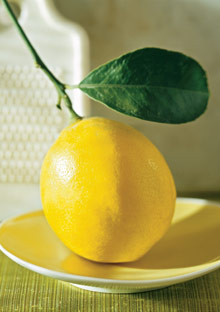Just Squeeze Me! How to Liven Up Your Meals With Lemon

Photo: Richard Jung
When life gives you lemons, enliven soups ! Tart up a pasta ! Surprise shrimp ! Do a tang-up job on spring vegetables ! And create the creamiest, sweet-and-sour-iest dessert you've ever tasted (pass the gingersnap crust)!
The old masters revered lemons for their beauty and gave them a starring role. Gorgeous specimens with glossy, bright skins appear in Dutch paintings half-peeled and placed like jewels next to green glass goblets and braces of pheasants. In the Court of Louis XIV, the ladies of Versailles used lemons as a cosmetic, biting into them to make their lips red. And for California Gold Rush miners, the vitamin C–rich fruit was treasured as a defense against scurvy, and fetched up to a dollar apiece (quite a sum in 1849). Nowadays we take lemons for granted. But they deserve another look. Lemons can transform sweet and savory dishes with an almost magical effect. A squeeze of lemon juice will animate a simple fillet of fish, cut the grease in fried food, perk up a dressing, or flavor a drink. And lemons are not just for seasoning. In North Africa, the citrus is preserved in brine and served as a condiment with stews, salads, and poultry; Italians cook lemon slices with meat and eat the softened flesh, skin and all.
When cooking with lemons, remember that they yield the most juice if you use them at room temperature, not straight from the refrigerator. (Set them in a bowl of warm water if you're pressed for time.) Rolling them on the counter before squeezing also helps. Since citrus is often treated with wax, fungicides, and other preservatives, scrub lemons well if you are using the zest for a recipe. Better still, buy organic lemons, which are grown without synthetic fertilizers and pesticides.
Exquisite, fragrant, and flavorful, these juicy fruits will make almost any dish—from the simplest shrimp sauté to a pillowy mousse-filled tart —into a sunny delight.



